Mobility during the COVID-19 Pandemic: A Data-Driven Time-Geographic Analysis of Health-Induced Mobility Changes
Abstract
1. Introduction
2. Setting the Scene
2.1. COVID-19: A New Challenge in Geographical Research
2.2. Aggregate Mobility Changes
3. Materials and Methods
3.1. Data and Research Area
3.2. Measuring Time-Space Mobility Patterns
3.3. Population Register Usage
4. Empirical Results
4.1. Changes in Standard Deviational Ellipses Over Time
4.2. Socio-Demographics and Time Geography
5. Conclusions
Author Contributions
Funding
Institutional Review Board Statement
Informed Consent Statement
Acknowledgments
Conflicts of Interest
Appendix A. Standard Deviational Ellipse (SDE)


Appendix A.1. Calculating Activity Spaces Using a Standard Deviational Ellipse (SDE)
| 1 Dimensional Data | 2-Dimensional Data | 3-Dimensional Data | Percentage of Data Points | |
|---|---|---|---|---|
| 1 standard deviation | 1.00 | 1.41 | 1.73 | 68% |
| 2 standard deviations | 2.00 | 2.83 | 3.46 | 95% |
| 3 standard deviations | 3.00 | 4.24 | 5.20 | 99% |

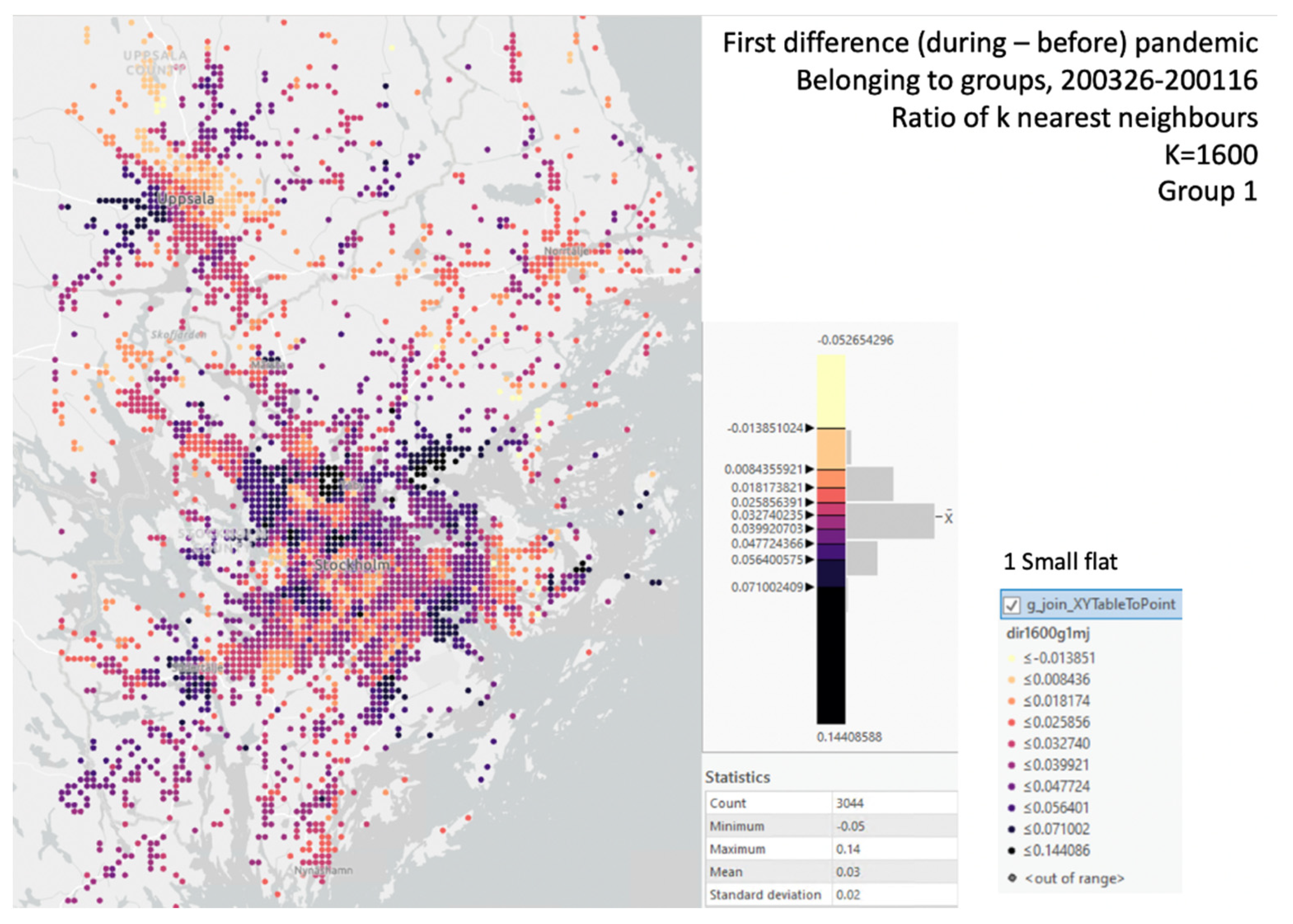
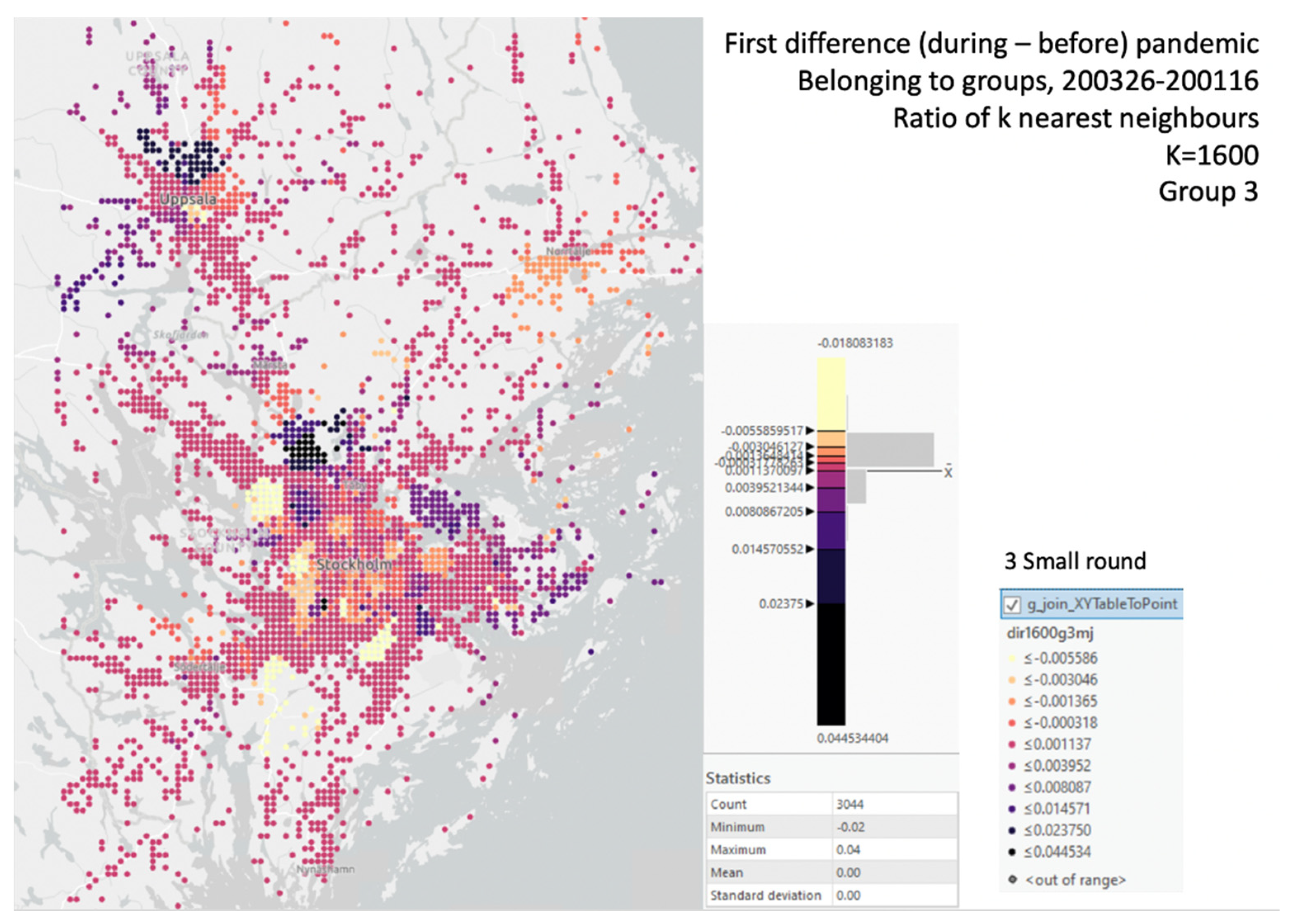
References
- Bailey, D.; Clark, J.; Colombelli, A.; Corradini, C.; De Propris, L.; Derudder, B.; Fratesi, U.; Fritsch, M.; Harrison, J.; Hatfield, M.; et al. Regions in a time of pandemic. Reg. Stud. 2020, 54, 1163–1174. [Google Scholar] [CrossRef]
- Florida, R.; Rodríguez-Pose, A.; Storper, M. Cities in a Post-COVID World; Papers in Evolutionary Economic Geography (PEEG) 2041; Utrecht University: Utrecht, The Netherlands, 2020; p. 29. [Google Scholar]
- Pullano, G.; Valdano, E.; Scarpa, N.; Rubrichi, S.; Colizza, V. Evaluating the effect of demographic factors, socioeconomic factors, and risk aversion on mobility during the COVID-19 epidemic in France under lockdown: A population-based study. Lancet Digit. Health 2020, 2, e638–e649. [Google Scholar] [CrossRef]
- Dahlberg, M.; Edin, P.-A.; Grönqvist, E.; Lyhagen, J.; Östh, J.; Siretskiy, A.; Toger, M. Effects of the COVID-19 pandemic on population mobility under mild policies: Causal evidence from Sweden. arXiv 2020, arXiv:2004.09087. [Google Scholar]
- Warren, M.S.; Skillman, S.W. Mobility changes in response to COVID-19. arXiv 2020, arXiv:2003.14228. [Google Scholar]
- Linka, K.; Goriely, A.; Kuhl, E. Global and local mobility as a barometer for COVID-19 dynamics. Biomech. Model. Mechanobiol. 2021, 20, 651–669. [Google Scholar] [CrossRef]
- Gao, S.; Rao, J.; Kang, Y.; Liang, Y.; Kruse, J. Mapping county-level mobility pattern changes in the united states in response to COVID-19. arXiv 2020, arXiv:2004.04544. [Google Scholar]
- Pase, F.; Chiariotti, F.; Zanella, A.; Zorzi, M. Bike sharing and urban mobility in a post-pandemic world. IEEE Access 2020, 8, 187291–187306. [Google Scholar] [CrossRef]
- Doubleday, A.; Choe, Y.; Isaksen, T.B.; Miles, S.; Errett, N.A. How did outdoor biking and walking change during COVID-19? A case study of three U.S. cities. PLoS ONE 2021, 16, e0245514. [Google Scholar] [CrossRef]
- Leyland, L.-A.; Spencer, B.; Beale, N.; Jones, T.; Van Reekum, C.M. The effect of cycling on cognitive function and well-being in older adults. PLoS ONE 2019, 14, e0211779. [Google Scholar] [CrossRef] [PubMed]
- SCB Sweden. Transport Sector Falls during the Coronavirus Crisis. Statistical News from Statistics Sweden 2020. Available online: https://www.scb.se/en/About-us/news-and-press-releases/transport-sector-falls-during-the-coronavirus-crisis/ (accessed on 20 January 2021).
- Hägerstrand, T. What about people in regional science? Pap. Reg. Sci. 1970, 24, 7–24. [Google Scholar] [CrossRef]
- Hacker, J.; Brocke, J.V.; Handali, J.; Otto, M.; Schneider, J. Virtually in this together—How web-conferencing systems enabled a new virtual togetherness during the COVID-19 crisis. Eur. J. Inf. Syst. 2020, 29, 563–584. [Google Scholar] [CrossRef]
- Östh, J.; Shuttleworth, I.; Niedomysl, T. Spatial and temporal patterns of economic segregation in Sweden’s metropolitan areas: A mobility approach. Environ. Plan. A Econ. Space 2018, 50, 809–825. [Google Scholar] [CrossRef]
- Östh, J.; Reggiani, A.; Schintler, L. Hierarchy, Central Place Theory and Computational Modelling. In Handbook on Entropy, Complexity and Spatial Dynamics: A Rebirth of Theory? Reggiani, A., Schintler, L., Czamanski, D., Partuelli, R., Eds.; Edward Elgar Publishing Ltd.: Cheltenham, UK, Forthcoming.
- Ratti, C.; Frenchman, D.; Pulselli, R.M.; Williams, S. Mobile landscapes: Using location data from cell phones for urban analysis. Environ. Plan. B Plan. Des. 2006, 33, 727–748. [Google Scholar] [CrossRef]
- Botta, F.; Moat, H.S.; Preis, T. Quantifying crowd size with mobile phone and Twitter data. R. Soc. Open Sci. 2015, 2, 150162. [Google Scholar] [CrossRef] [PubMed]
- Ellegård, K. Time Geography; Routledge Studies in Human Geography; Routledge: Abingdon, UK; New York, NY, USA, 2018; ISBN 978-1-138-57379-6. [Google Scholar]
- Wang, J.; Kwan, M.-P. Hexagon-based adaptive crystal growth voronoi diagrams based on weighted planes for service area delimitation. Int. J. Geoinf. 2018, 7, 257. [Google Scholar] [CrossRef]
- Wang, J.; Kwan, M.-P. An analytical framework for integrating the spatiotemporal dynamics of environmental context and individual mobility in exposure assessment: A study on the relationship between food environment exposures and body weight. Int. J. Environ. Res. Public Health 2018, 15, 2022. [Google Scholar] [CrossRef]
- Borsekova, K.; Nijkamp, P. Resilience and Urban Disasters: Surviving Cities; Edward Elgar Publishing: Cheltenham, UK, 2019; ISBN 1-78897-010-1. [Google Scholar]
- Jiang, S.; Yang, Y.; Gupta, S.; Veneziano, D.; Athavale, S.; González, M.C. The TimeGeo modeling framework for urban mobility without travel surveys. Proc. Natl. Acad. Sci. USA 2016, 113, E5370–E5378. [Google Scholar] [CrossRef] [PubMed]
- Kourtit, K.; Nijkamp, P.; Toger, M. Sustainable cities, quality of life and mobility-related happiness. In Urban Happiness; Springer International Publishing: Cham, Switzerland, Forthcoming.
- Hasanzadeh, K.; Czepkiewicz, M.; Heinonen, J.; Kyttä, M.; Ala-Mantila, S.; Ottelin, J. Beyond geometries of activity spaces: A holistic study of daily travel patterns, individual characteristics, and perceived wellbeing in Helsinki metropolitan area. J. Transp. Land Use 2019, 12. [Google Scholar] [CrossRef]
- Grinberger, A.Y.; Shoval, N.; McKercher, B. Typologies of tourists’ time–space consumption: A new approach using GPS data and GIS tools. Tour. Geogr. 2014, 16, 105–123. [Google Scholar] [CrossRef]
- Shoval, N.; McKercher, B.; Birenboim, A.; Ng, E. The application of a sequence alignment method to the creation of typologies of tourist activity in time and space. Environ. Plan. B Plan. Des. 2015, 42, 76–94. [Google Scholar] [CrossRef]
- Wang, Z.; He, S.Y.; Leung, Y. Applying mobile phone data to travel behaviour research: A literature review. Travel Behav. Soc. 2018, 11, 141–155. [Google Scholar] [CrossRef]
- Järv, O.; Ahas, R.; Witlox, F. Understanding monthly variability in human activity spaces: A twelve-month study using mobile phone call detail records. Transp. Res. Part C Emerg. Technol. 2014, 38, 122–135. [Google Scholar] [CrossRef]
- Chen, B.Y.; Wang, Y.; Wang, D.; Li, Q.; Lam, W.H.K.; Shaw, S.-L. Understanding the impacts of human mobility on accessibility using massive mobile phone tracking data. Ann. Am. Assoc. Geogr. 2018, 108, 1115–1133. [Google Scholar] [CrossRef]
- Osorio-Arjona, J.; García-Palomares, J.C. Social media and urban mobility: Using twitter to calculate home-work travel matrices. Cities 2019, 89, 268–280. [Google Scholar] [CrossRef]
- Raun, J.; Ahas, R.; Tiru, M. Measuring tourism destinations using mobile tracking data. Tour. Manag. 2016, 57, 202–212. [Google Scholar] [CrossRef]
- Kovács, Z.; Vida, G.; Elekes, Á.; Kovalcsik, T. Combining social media and mobile positioning data in the analysis of tourist flows: A case study from Szeged, Hungary. Sustainability 2021, 13, 2926. [Google Scholar] [CrossRef]
- Ellegård, K.; Svedin, U. Torsten Hägerstrand’s time-geography as the cradle of the activity approach in transport geography. J. Transp. Geogr. 2012, 23, 17–25. [Google Scholar] [CrossRef]
- Klapka, P.; Ellegård, K.; Frantál, B. What about time-geography in the post-Covid-19 era? Morav. Geogr. Rep. 2020, 28, 238–247. [Google Scholar] [CrossRef]
- Bin, E.; Andruetto, C.; Susilo, Y.; Pernestål, A. The trade-off behaviours between virtual and physical activities during the first wave of the COVID-19 pandemic period. Eur. Transp. Res. Rev. 2021, 13, 1–19. [Google Scholar] [CrossRef]
- Couclelis, H. Rethinking Time Geography in the Information Age. Environ. Plan. A Econ. Space 2009, 41, 1556–1575. [Google Scholar] [CrossRef]
- Nimrod, G. Technostress in a hostile world: Older internet users before and during the COVID-19 pandemic. Aging Ment. Health 2020, 1–8. [Google Scholar] [CrossRef]
- Mokhtarian, P. Teleworking and Mobility: What Do We (Think We) Know and Not Know? 2020. Available online: https://www.slideshare.net/OECDLEED/teleworking-and-mobility-what-do-we-think-we-know-and-not-know-patricia-mokhtarian (accessed on 20 January 2021).
- Couclelis, H. There will be no Post-COVID city. Environ. Plan. B Urban Anal. City Sci. 2020, 47, 1121–1123. [Google Scholar] [CrossRef]
- Hughes, C.J. Coronavirus escape: To the suburbs. The New York Times, 8 May 2020; 7. Available online: https://www.nytimes.com/2020/05/08/realestate/coronavirus-escape-city-to-suburbs.html (accessed on 20 January 2021).
- SCB Sweden. Real Estate Prices for One- or Two-Dwelling Buildings Rose in the Third Quarter 2020. Statistical news from Statistics Sweden 2020. Available online: https://www.scb.se/en/finding-statistics/statistics-by-subject-area/housing-construction-and-building/real-estate-prices-and-registrations-of-title/real-estate-prices-and-registrations-of-title/pong/statistical-news/real-estate-prices-and-registration-of-title-4th-quarter-of-2019/ (accessed on 20 January 2021).
- BBC Worklife Coronavirus: How the World of Work May Change Forever. BBC Worklife, Unknown Questions 2020. Available online: https://www.bbc.com/worklife/article/20201023-coronavirus-how-will-the-pandemic-change-the-way-we-work (accessed on 20 January 2021).
- Fairchild, C. WFH Is a Problem for Parents. Returning to the Office Won’t Solve It. Working Together, A Weekly Newsletter on Equity in the Workplace from LinkedIn News 2020. Available online: https://www.linkedin.com/pulse/wfh-problem-parents-returning-office-wont-solve-caroline-fairchild/work (accessed on 20 January 2021).
- Toger, M.; Shuttleworth, I.; Östh, J. How average is average? Temporal patterns in human behaviour as measured by mobile phone data—Or why chose Thursdays. arXiv 2020, arXiv:2005.00137. [Google Scholar]
- Thrift, N. An Introduction to Time-Geography: Concepts and Techniques in Modern Geography; Geo Abstracts Ltd.: Norwich, UK, 1977. [Google Scholar]
- Schaerström, A. The potential for time geography in health studies. In Geography and Health—A Nordic Outlook; The Swedish National Defence College: Stockholm, Sweden, 2015. [Google Scholar] [CrossRef]
- Wang, Y.; Kang, C.; Bettencourt, L.M.A.; Liu, Y.; Andris, C. Linked activity spaces: Embedding social networks in urban space. In Computational Approaches for Urban Environments; Helbich, M., Jokar Arsanjani, J., Leitner, M., Eds.; Springer International Publishing: Cham, Switzerland, 2015; pp. 313–336. ISBN 978-3-319-11468-2. [Google Scholar]
- Smith, L.; Foley, L.; Panter, J. Activity spaces in studies of the environment and physical activity: A review and synthesis of implications for causality. Health Place 2019, 58, 102113. [Google Scholar] [CrossRef] [PubMed]
- Schönfelder, S.; Axhausen, K.W. Activity spaces: Measures of social exclusion? Transp. Policy 2003, 10, 273–286. [Google Scholar] [CrossRef]
- Huang, X.; Li, Z.; Jiang, Y.; Li, X.; Porter, D. Twitter reveals human mobility dynamics during the COVID-19 pandemic. PLoS ONE 2020, 15, e0241957. [Google Scholar] [CrossRef] [PubMed]
- Östh, J. Introducing the EquiPop Software; Uppsala University: Uppsala, Sweden, 2014. [Google Scholar]
- Östh, J.; Türk, U. Integrating infrastructure and accessibility in measures of bespoke neighbourhoods. In Handbook of Urban Segregation; Edward Elgar Publishing: Cheltenham, UK, 2020; pp. 378–394. [Google Scholar]
- Davidsson, P.; Thoresson, A. IIS survey Swedes and Internet 2017. Available online: http://www.soi2017.se/allmant-om-utvecklingen/innehav-av-utrustning/ (accessed on 20 January 2021).
- Esri Inc. ArcGIS Pro; Esri Inc.: Redlands, CA, USA, 2020. [Google Scholar]
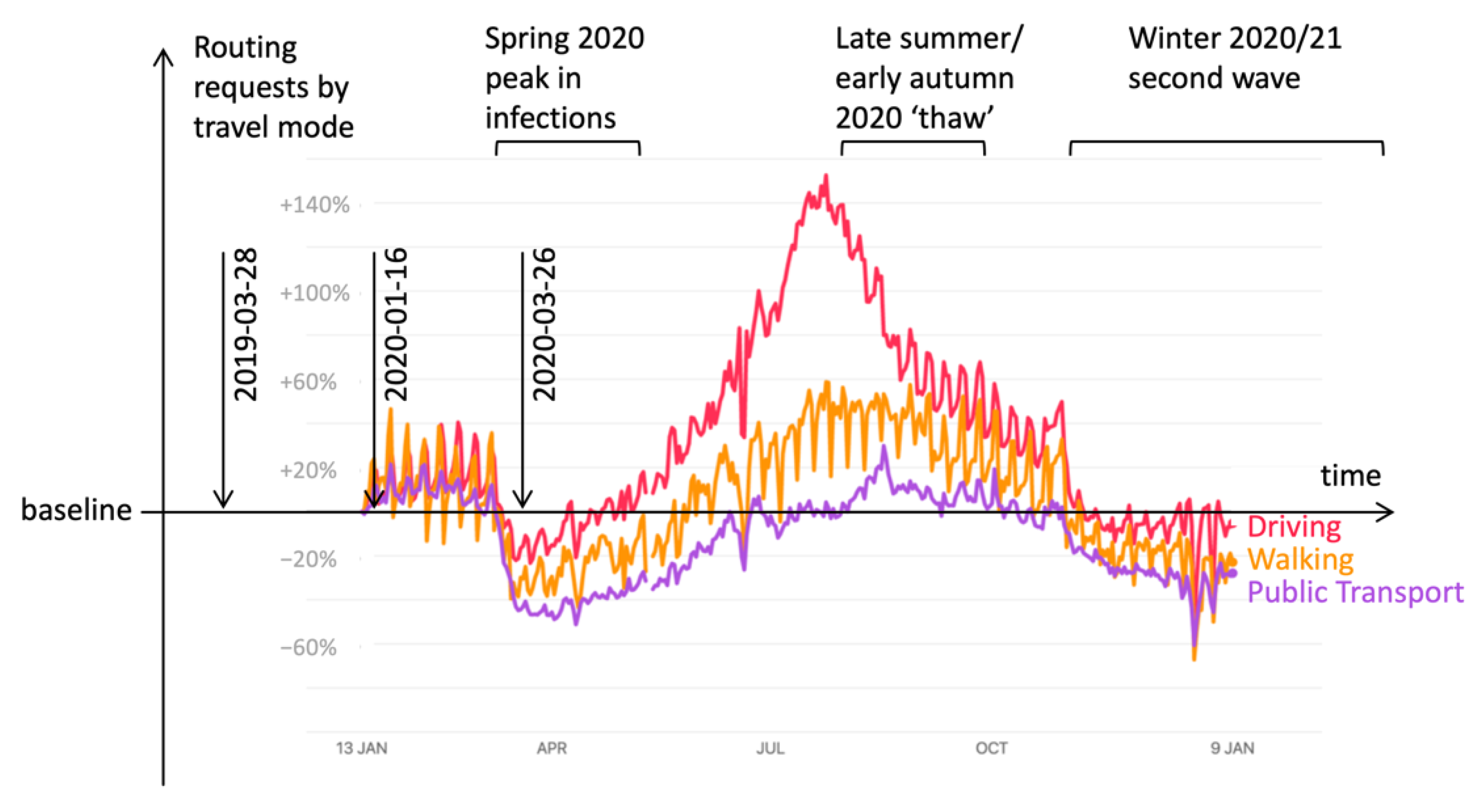
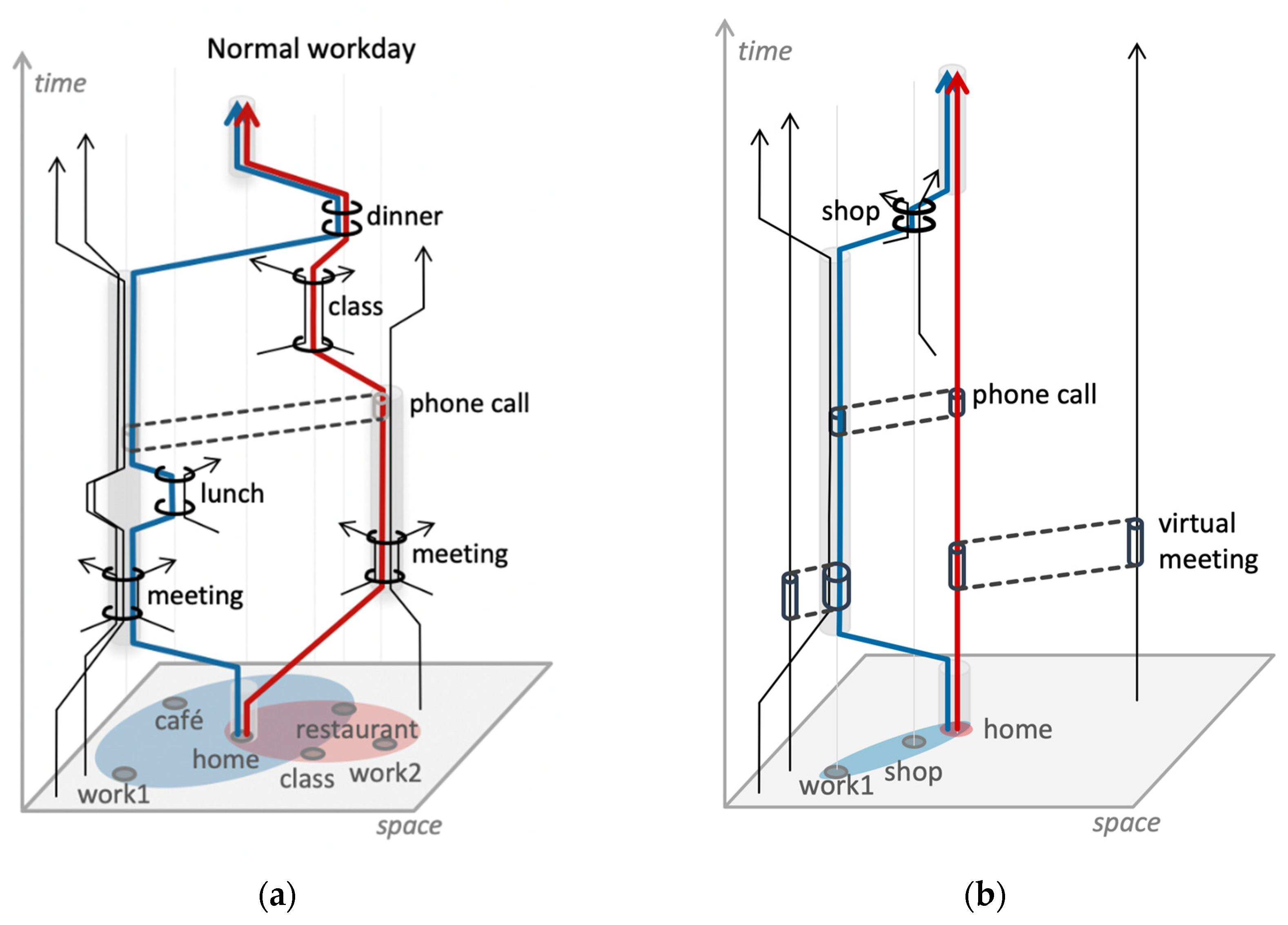
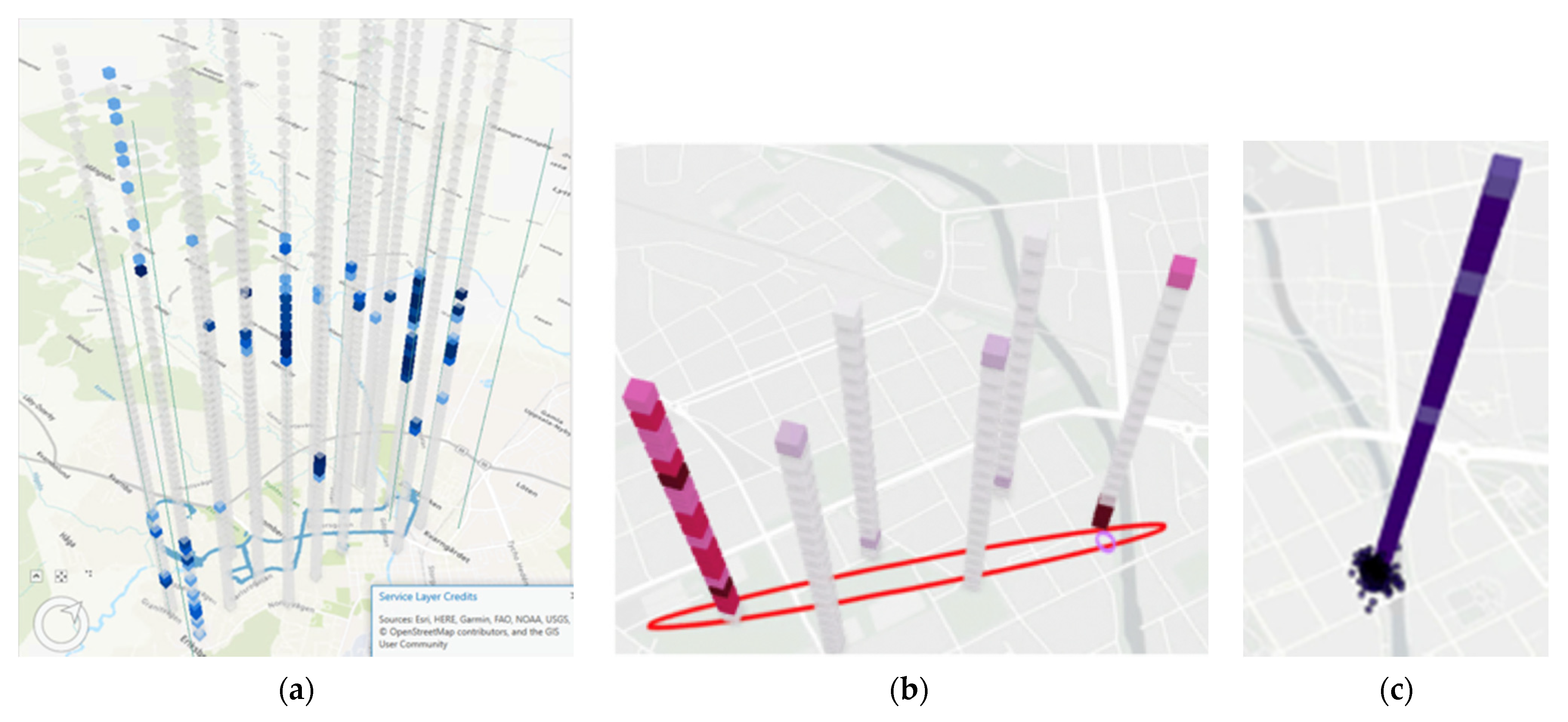

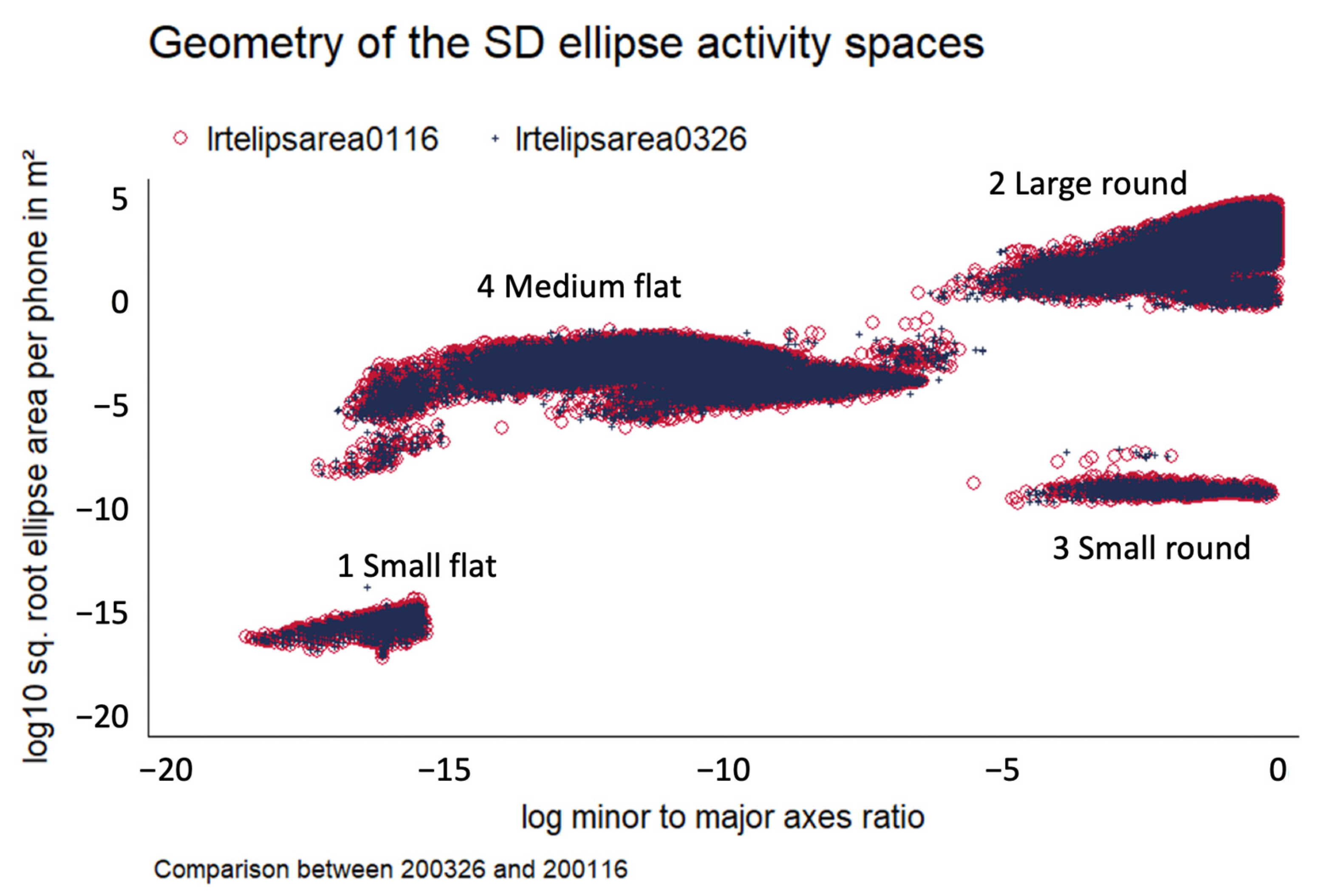
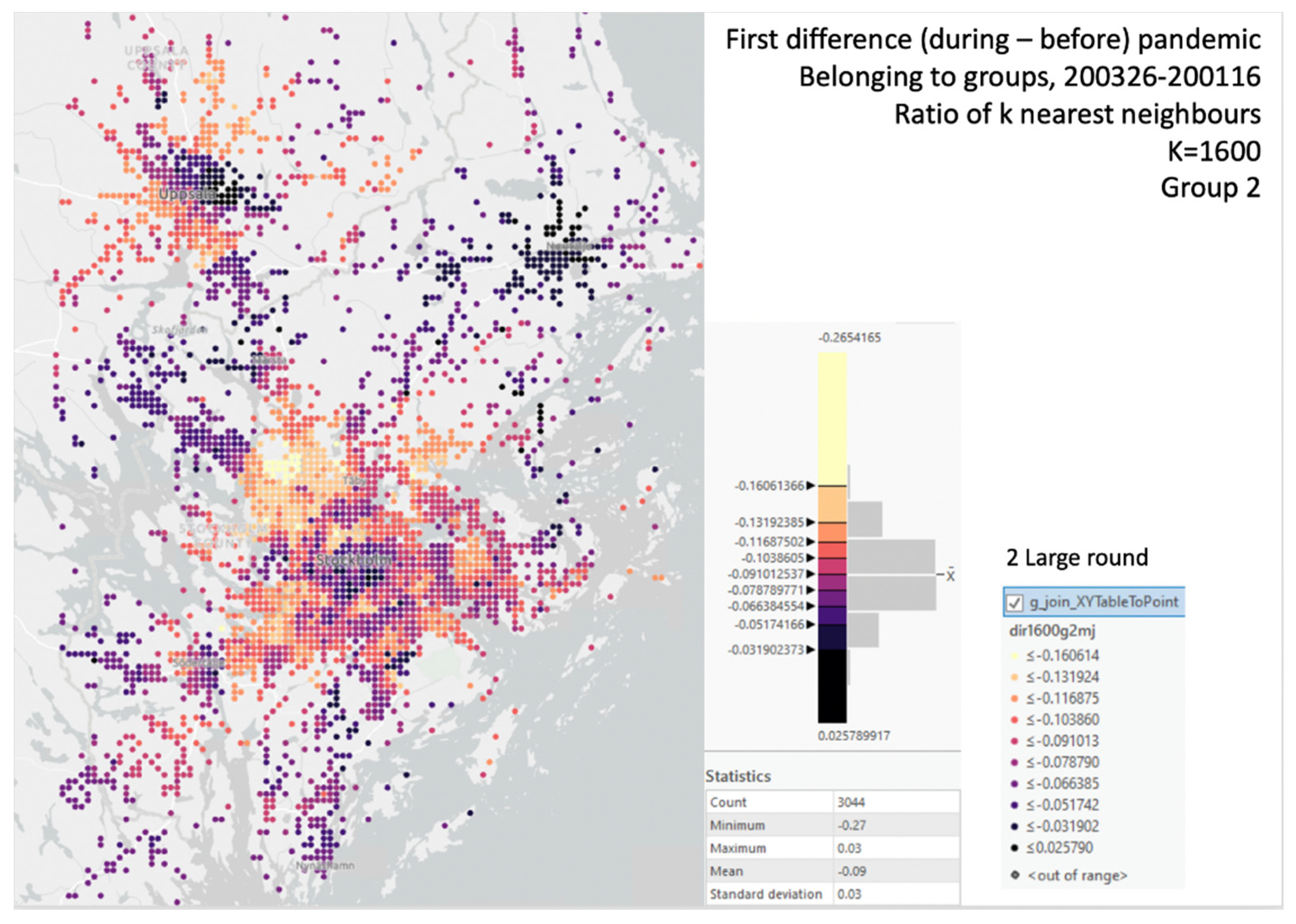
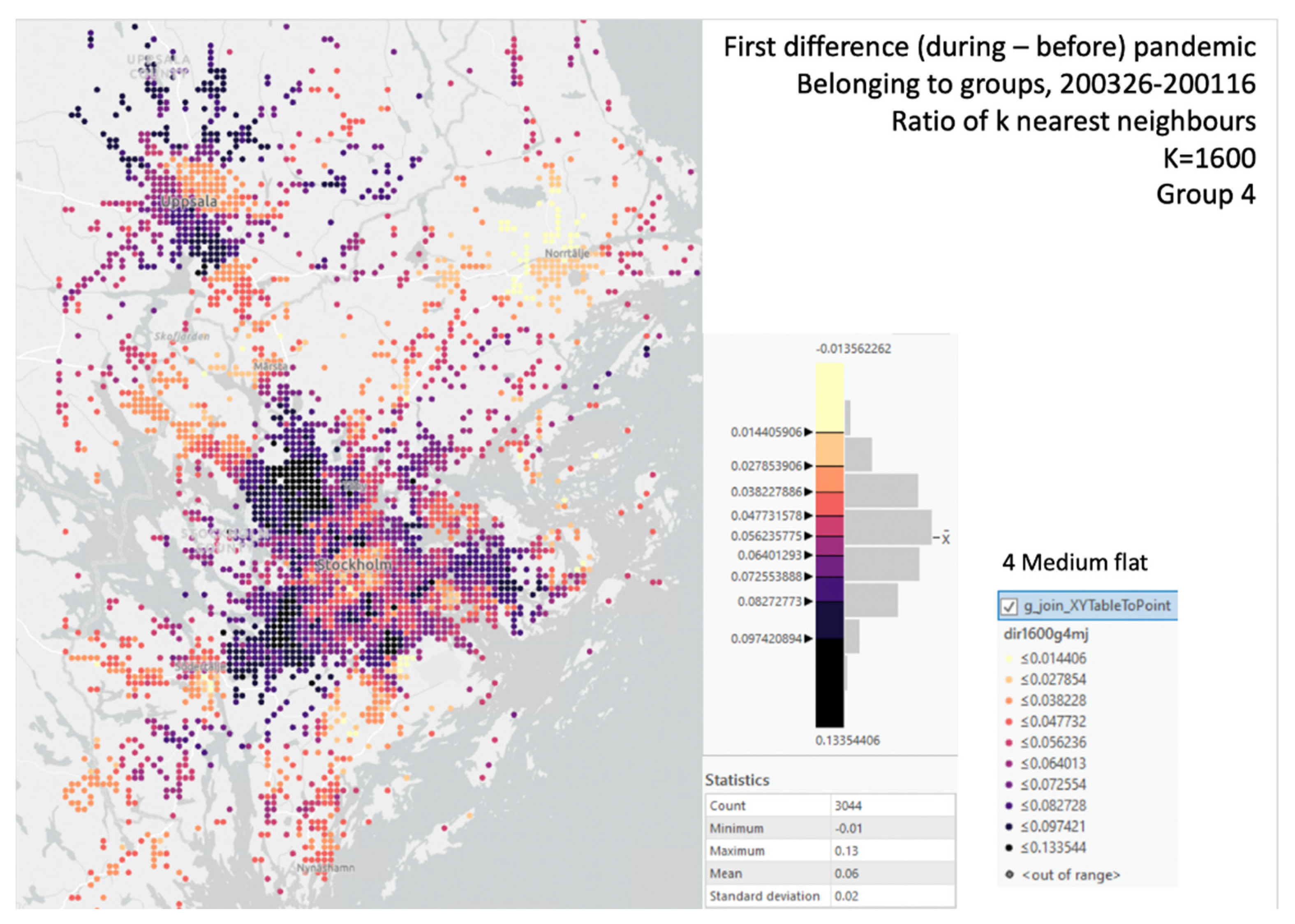
| Variable | Dates | Mean | SD | SE | Min | Mdn | Max |
|---|---|---|---|---|---|---|---|
| Each date | |||||||
| Ellipse area per phone, km2 | 20116 | 46.63 | 182.774 | 0.216 | 0 | 0.66 | 5136.99 |
| 20326 | 30.32 | 137.804 | 0.279 | 0 | 2.77 | 6850.03 | |
| Minor to major axes ratio | 20116 | 0.2071 | 0.2031 | 0.0004 | 0 | 0.14 | 1 |
| 20326 | 0.2032 | 0.2195 | 0.0003 | 0 | 0.15 | 1 | |
| Difference between dates | |||||||
| Ellipse area per phone, km2 | 20326-20116 | −9.02 | 141.911 | 0.248 | −4718.2 | −0.06 | 5070.4 |
| Minor to major axes ratio | 20326-20116 | −0.0035 | 0.2484 | 0.0004 | −1 | 0 | 0.99 |
| grp | 1—Small Flat | 2—Large Round | 3—Small Round | 4—Medium Flat | Total |
|---|---|---|---|---|---|
| Perc.0326 | 8.8 | 62.7 | 0.3 | 28.2 | 100 |
| Perc.0116 | 6.3 | 72.1 | 0.3 | 21.3 | 100 |
| Transition Matrix | grp0326 | ||||
|---|---|---|---|---|---|
| grp0116 | 1 Small Flat | 2 Large Round | 3 Small Round | 4 Medium Flat | Total |
| 1 small flat | 0.338 | 0.019 | 0.093 | 0.087 | 0.065 |
| 2 large round | 0.390 | 0.891 | 0.407 | 0.522 | 0.751 |
| 3 small round | 0.006 | 0.001 | 0.253 | 0.004 | 0.003 |
| 4 medium flat | 0.266 | 0.089 | 0.247 | 0.388 | 0.182 |
| Total | 1 | 1 | 1 | 1 | 1 |
| (1) | (2) | (3) | (4) | |
|---|---|---|---|---|
| Beta (S.E.)Sign | Beta (S.E.)Sign | Beta (S.E.)Sign | Beta (S.E.)Sign | |
| Dependent Variable: First Diff in Share 800 NN | Group g1 Small Flat | Group g2 Large Round | Group g3 Small Round | Group g4 Medium Flat |
| Sociodemographics | ||||
| Higher education | 0.021879 (0.0085) * | −0.099 (0.014) *** | −0.004131 (0.0027) | 0.081516 (0.0111) *** |
| Lower education | 0.007872 (0.0157) | −0.025 (0.026) | −0.015297 (0.005) ** | 0.031979 (0.0205) |
| VM | 0.041475 (0.0086) *** | −0.147 (0.014) *** | 0.004015 (0.0027) | 0.101914 (0.0112) *** |
| Poverty | −0.014983 (0.0174) | 0.175 (0.029) *** | 0.000182 (0.0055) | −0.160255 (0.0226) *** |
| Wealth | 0.036343 (0.0106) *** | 0.025 (0.018) | −0.004769 (0.0034) | −0.056144 (0.0138) *** |
| Labour market | ||||
| Distance to 500 jobs | 0.000001 (0) *** | −0.003331 (0) *** | 0.000000 (0) | 0.000002 (0) *** |
| Local jobs | −0.000002 (0) | 0.005759 (0) ** | 0.000000 (0) | −0.000004 (0) ** |
| Unemployment | −0.006296 (0.0218) | 0.087 (0.036) * | −0.009839 (0.0069) | −0.071034 (0.0285) * |
| Phone variables | ||||
| Distance to 500 phones | −0.000002 (0) *** | 0.003066 (0) ** | 0.000000 (0) * | −0.000001 (0) |
| phone density per km2 | −0.000001 (0) ** | 0.001508 (0) ** | 0.000000 (0) * | −0.000001 (0) |
| (Constant) | 0.019194 (0.0037) *** | −0.069 (0.006) *** | 0.006183 (0.0012) *** | 0.043863 (0.0048) *** |
| adj. R2 | 0.046 | 0.106 | 0.100 | 0.080 |
Publisher’s Note: MDPI stays neutral with regard to jurisdictional claims in published maps and institutional affiliations. |
© 2021 by the authors. Licensee MDPI, Basel, Switzerland. This article is an open access article distributed under the terms and conditions of the Creative Commons Attribution (CC BY) license (https://creativecommons.org/licenses/by/4.0/).
Share and Cite
Toger, M.; Kourtit, K.; Nijkamp, P.; Östh, J. Mobility during the COVID-19 Pandemic: A Data-Driven Time-Geographic Analysis of Health-Induced Mobility Changes. Sustainability 2021, 13, 4027. https://doi.org/10.3390/su13074027
Toger M, Kourtit K, Nijkamp P, Östh J. Mobility during the COVID-19 Pandemic: A Data-Driven Time-Geographic Analysis of Health-Induced Mobility Changes. Sustainability. 2021; 13(7):4027. https://doi.org/10.3390/su13074027
Chicago/Turabian StyleToger, Marina, Karima Kourtit, Peter Nijkamp, and John Östh. 2021. "Mobility during the COVID-19 Pandemic: A Data-Driven Time-Geographic Analysis of Health-Induced Mobility Changes" Sustainability 13, no. 7: 4027. https://doi.org/10.3390/su13074027
APA StyleToger, M., Kourtit, K., Nijkamp, P., & Östh, J. (2021). Mobility during the COVID-19 Pandemic: A Data-Driven Time-Geographic Analysis of Health-Induced Mobility Changes. Sustainability, 13(7), 4027. https://doi.org/10.3390/su13074027









